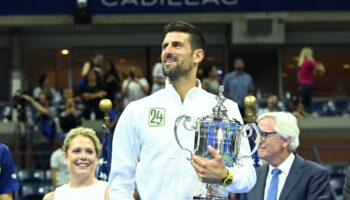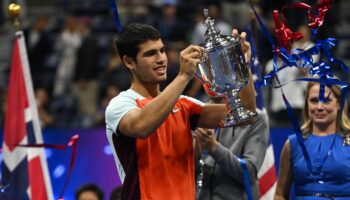
*(Click here for Part 1 of Opening Serve)*
Eugenie Bouchard was the talk of the WTA Tour for the first half of the year before hitting a serious wall in the summer. Was that just a blip on the radar on the way to an even better 2015, or are we still in the “too much, too soon” stage with Genie?
Gabe: People I know who have been around her did not have many kind words about Bouchard or her family. Personally, I find her style of play hard to watch. But, there’s no disputing that she played well at the majors (sort of like Sloane Stephens in 2013) and was eagerly promoted as the The Blonde by the WTA. She will have a lot of points to defend, but I see her remaining comfortably in the Top 10 this year, barring injury. Not many in the 11-20 ranking group seem poised to make much of an upward movement.
Brad: But Genie is one of the hubris people I was talking about! She’s not in this to make friends. Everybody knows she got wiped off the court by Petra Kvitova in the Wimbledon final, and her year before and after that match look vastly different. Kvitova played a perfect match on that grass, so perfect I might have thought Genie would just chalk it up to something that was just not meant to be. She seemed to have taken it as a match in which she felt humiliated. But if she can look at 2015 as a clean slate, that attitude will play no small part in keeping her in the Top 10 – she will stay afloat partly on the back of how much she feels she belongs there! If you took a microscope to her game, there are some fundamental problems with stroke production (that funky elbow!), so I’m totally curious to see whether that is something that new coaches will address.
Should we have any lofty expectations for either Victoria Azarenka or Juan Martin del Potro, two former Grand Slam champions who are working their way back to form after the injury bug bit them once again last year?
GG: I would dearly love to see these two back in fighting form. Azarenka, at her full powers, was the perfect foil for Serena. Their matches were electric, tense, gutsy, physical battles. The WTA could use her back in the fold. But she needs her body to cooperate. She can only do so much with that self-confidence and never-die attitude if her body doesn’t cooperate. Unfortunately, it wasn’t just last year that was an injury year for her. She has always had physical ailments. And, now ranked No. 41, she will face tough early-round matches. But, if she is in top form, it is the other players who will dread facing her in those early rounds. Del Potro, currently ranked No. 338, has delicate wrists. That is not a good thing for a tennis player. I don’t see his body holding together for very long, but it could last the bulk of this year and could see him producing some big wins. His game is a thing of beauty and finesse. He is a throwback and, as such, probably would have been better off playing in those less physically demanding days. I sometimes wonder whether any player is ever playing pain-free, these days. The physical toll has increased significantly, and, with it, the consistency level has nosedived.
BW: I can’t say it better than that, or even differently. I think Azarenka is more important to the landscape of the women’s tour than Delpo is to the men’s, and yet I think I will be rooting harder for the Argentine. I love watching his howitzer shots hit so gracefully.
Not only did Serena Williams almost go the entire season last year without a major, she experienced more off days against lower-ranked competition than in any other year in which she was relatively healthy throughout. Is this now par for the course for Serena?
BW: The motivational brownouts seem only to come in the early stages of events. If she makes it to the semis, every component of her winning formula seems to be in place. So after her career is over, we will see some curious ups-and-downs in her record.
GG: Yes. Serena has been playing in the big leagues for 17 years. She is 33 years old. She has won everything that needs to be won. She has no real equal (well, Alizé Cornet seems to have her number). She cannot muster the motivation every day, even when a Grand Slam title is near. She will have those unexpected losses, but, if she can get one or two more Grand Slams under her belt, she will break the tie with Martina and Chris and get within distance of Steffi Graf’s Open-era record of 22 Grand Slam singles titles (and, without the Seles-stabbing asterisk that is associated with Graf’s record).
We just made you the commissioner/rules czar for this year, effective immediately. The first rule change/alteration to the game you would make would be…?

GG: Eliminate the medical time out. It’s used too often, it is often abused, and it can really affect the outcome of a match. And, it’s terrible for the spectators. It’s getting to be like World Cup soccer with the questionable injury displays. If the other player trained better, prepared better, is better conditioned, that is an advantage that he or she should have. Some might argue that, without the medical time out, there would be many more defaults or mid-match retirements. But, guess what? There are already a lot of those. My feeling is that, were the medical time out eliminated, players would decide, nine times out of 10, that, gee whiz, the ailment is not that bad and that they can play on.
BW: Amen, and amen. As long as Gabe promises to do that, I would slowly reintroduce a wider variation of court surfaces. The speed and bounce of supposedly “different” playing surfaces has become so homogenized that playing styles have followed suit. The game has become far less strategic. More tournaments on green clay and grass would head off some injuries. Many of today’s players who like playing indoors don’t really know what it’s like to play “on carpet,” because the arena has laid down something transplanted from outdoors, something that invariably makes indoor play SLOW. As a younger person I poured so much fan interest into rooting for the game’s best counterpunchers to solve the serve-and-volley, and now I long to see more players leaving the baseline and expanding their repertoire of shots because the surface rewards it.
[About the authors: Western New Yorker Brad Wilber is a college librarian and crossword puzzle editor for the Chronicle of Higher Education. His tennis fandom began when he sat down in front of the TV for Super Saturday at the 1984 U.S. Open. For many years he has been a major statistical contributor to www.chrisevert.net. Gabe Gonzalez is a DC-area lawyer, whose love of tennis began as a teenager while growing up in Miami. He misses the ’80s because, not only was the music better, but he could play tennis after school every day. He considers Martina Navratilova the greatest tennis player of all time.]
Follow @Koiki_Sport
[Cover photo (Victoria Azarenka) courtesy of Bradley Kanaris/Getty Images AsiaPac]




